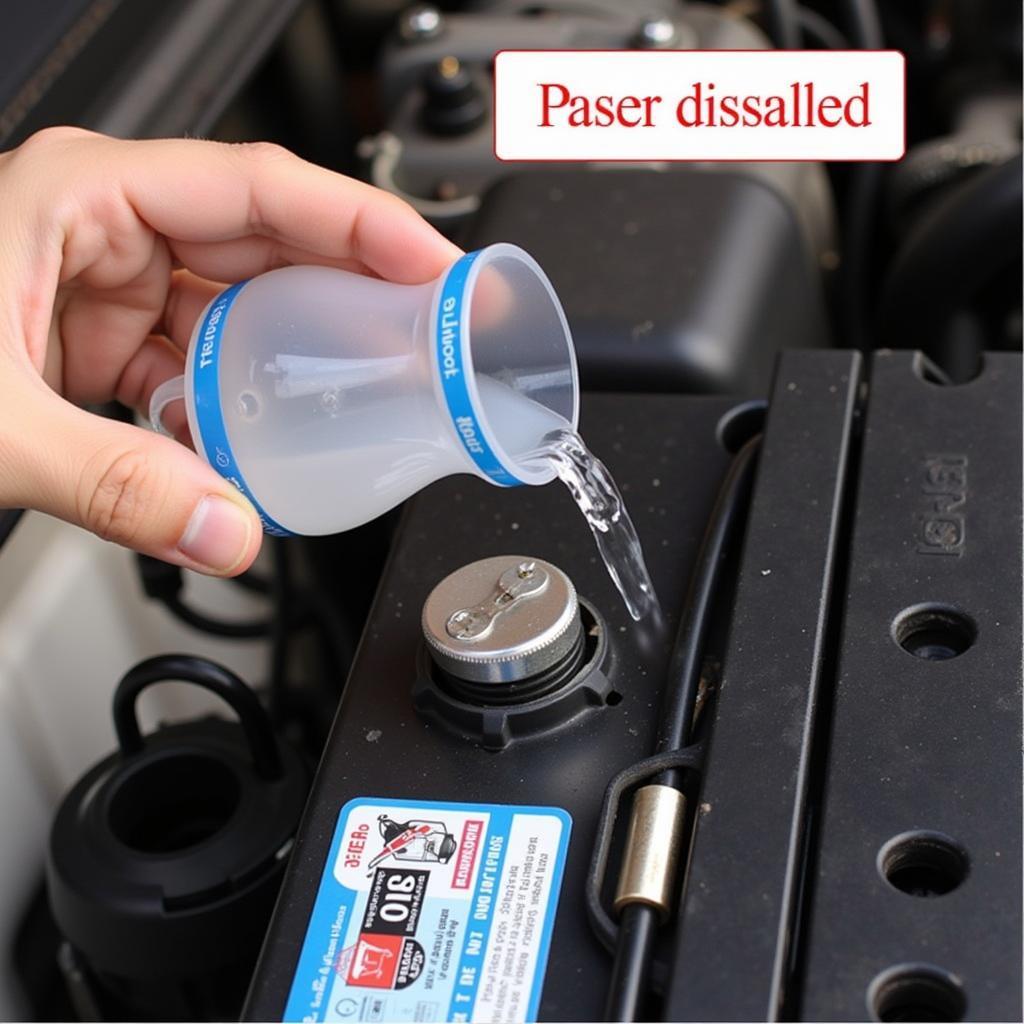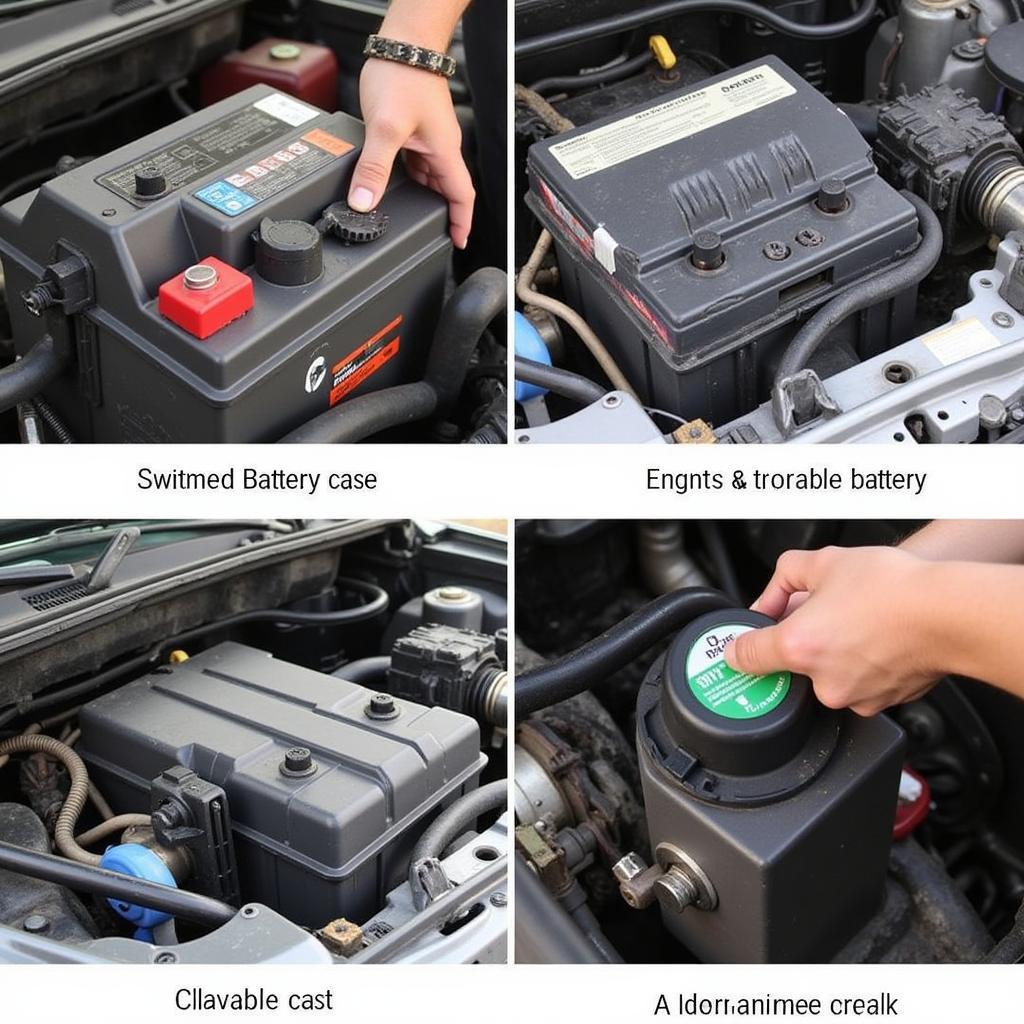Maintaining a car battery is crucial for a vehicle’s smooth operation. Many modern cars come equipped with maintenance-free batteries, leaving car owners wondering about proper care, including whether adding water is necessary or even advisable. This article delves into the intricacies of putting water in a maintenance-free car battery, addressing common misconceptions and providing practical guidance. You can also find helpful car maintenance tips for other parts of your vehicle.
Adding water to a conventional car battery is a standard procedure. However, the concept of “putting water in a maintenance-free car battery” often raises questions. Are maintenance-free batteries truly maintenance-free? What happens if the electrolyte levels drop? Let’s explore these concerns.
Maintenance-free batteries are designed to minimize the need for regular maintenance, such as topping off the electrolyte levels. They achieve this through advanced technologies and sealed construction. This design helps reduce water loss compared to traditional batteries. Still, understanding their operation is essential for maximizing their lifespan.
Understanding Maintenance-Free Car Batteries
What exactly makes a car battery “maintenance-free”? These batteries use technologies like calcium alloys in the grids, which reduce water consumption during the battery’s chemical reactions. They also employ a sealed design, often lacking the removable caps found in conventional batteries. This helps minimize water loss through evaporation.
 Maintenance-Free Car Battery Design
Maintenance-Free Car Battery Design
However, it’s a misconception that these batteries never need any attention. While they require significantly less maintenance than traditional batteries, they can still experience water loss under extreme conditions, like prolonged periods of high temperatures. This can lead to a decrease in the electrolyte level and impact the battery’s performance.
Can You Add Water to a Maintenance-Free Car Battery?
The answer isn’t a simple yes or no. While most maintenance-free batteries are sealed, some have small vent caps, often hidden under a sticker or cover. If you can locate these, it might be possible to add distilled water. However, this should be done cautiously and only after consulting your car’s owner’s manual or a qualified mechanic. Incorrectly adding water can damage the battery. For insights on preparing your car for colder climates, see our guide on car battery winter maintenance.
 Adding Distilled Water to a Car Battery
Adding Distilled Water to a Car Battery
Improperly adding water or using tap water (which contains minerals that can contaminate the battery) can shorten its lifespan. Remember, adding water is a last resort and should only be attempted if you’re confident in your ability and have the right tools and materials.
When Should You Consider Adding Water?
Several signs indicate low electrolyte levels. These include sluggish engine cranking, dim headlights, or a warning light on your dashboard. However, these symptoms can also indicate other battery issues, so it’s crucial to have your battery professionally tested before assuming it needs water. If you are in Minneapolis, read our tips on car maintenance winter minneapolis for dealing with cold-weather related car issues.
“Regularly checking your battery, even a maintenance-free one, can prevent unexpected issues and prolong its life,” says John Miller, a certified automotive technician with over 20 years of experience. He adds, “Don’t assume ‘maintenance-free’ means you can completely ignore it.”
What if You Can’t Add Water?
If your maintenance-free battery shows signs of low electrolyte and you can’t access any vent caps, replacement is usually the recommended course of action. Attempting to force open a sealed battery can be dangerous and may cause damage.
 Signs of a Bad Car Battery
Signs of a Bad Car Battery
Maintaining Your Maintenance-Free Battery
Even though they require less frequent attention, adopting good practices can extend the life of your maintenance-free battery. Avoid deep discharges, ensure the charging system functions correctly, and keep the battery clean. Regular cleaning of the battery terminals can prevent corrosion and ensure optimal electrical conductivity. For simple car maintenance tips that you can easily incorporate into your routine, check out our guide on easy car maintenance tips.
“Extreme temperatures, both hot and cold, can affect a battery’s performance,” explains Sarah Chen, a leading battery researcher at Auto Labs Inc. “Proper care can mitigate these effects.”
Conclusion
Putting water in a maintenance-free car battery is a complex topic. While some may allow it under specific circumstances, most are sealed and require replacement when their performance declines. Understanding the nature of maintenance-free batteries, recognizing signs of potential issues, and practicing good battery maintenance can help ensure reliable starting and extend the life of your battery. For any car battery or electrical system concerns, connect with AutoTipPro at +1 (641) 206-8880 or visit our office at 500 N St Mary’s St, San Antonio, TX 78205, United States. We are here to help!
 Checking Car Battery Voltage
Checking Car Battery Voltage
FAQ
- Do maintenance-free batteries ever need water? While rare, they might require water under extreme conditions.
- How can I tell if my maintenance-free battery is low on water? Signs include slow cranking, dim lights, and a warning light.
- Can I use tap water in my car battery? No, always use distilled water.
- What if I can’t add water to my maintenance-free battery? Replacement is usually the best option.
- How can I prolong the life of my maintenance-free battery? Avoid deep discharges, ensure a properly functioning charging system, and keep the battery clean.
- Is it safe to open a sealed car battery? No, it’s dangerous and could cause damage.
- What should I do if I’m unsure about my car battery’s health? Consult a qualified mechanic for professional testing and advice.






Leave a Reply